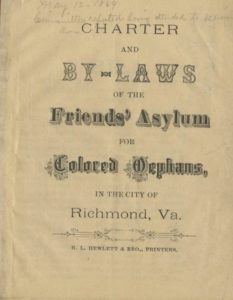
Organizational Charter
*On this date, in 1869, the Friends' Asylum for Colored Orphans was formed. It was a Black orphanage in Richmond, Virginia.
Later it was called the Friends Association for Colored Children and is currently the Friends' Association for Children. It began as a program to provide care and education to Black children. It later evolved into a foster care center, unwed mothers and pre-adoption boarding home, and a community daycare facility. It is currently operating as a family services organization. The city council authorized the building's location in 1867, and the orphanage opened two years later. Lucy Goode Brooks was instrumental in its establishment.
It was incorporated in 1872 by the Society of Friends, who had raised US$6,250 to erect a building at 112 West Charity Street. Its purpose was to provide care and education to orphaned African American children. The initial trustees were John B. Crenshaw, Jeremiah Willets, William H. Pleasants, Richard A. Ricks, and Walter A. Ricks, members of the Society of Friends; Rev. James H. Holmes, Nelson Vandervall, members of the First Baptist Church; Joseph E. Farrar, John Adams, members of Ebenezer Baptist Church; William Boyd, member of the Fifth Baptist church; Frederick Smith, Cooper, members of Mount Zion Baptist Church; P. H. Woolfork, member of Third-street Methodist church; and Thomas M. Hewlett, member of Manchester Baptist church.
Under the bylaws, parents gave all rights to their children. The board had the discretion to bond children into indenture until their age of majority–21 years for boys and 18 years for girls. Until 1889, only white trustees served on the board; only Black Baptist churches from Richmond could serve as trustees. The number varied according to the financial contribution of the involved churches. In 1902, were 22 children in attendance, seven of whom were newly admitted; one had run away, and three had died. Seventeen children were in attendance in 1914, and the officers were Rev. W. T. Johnson (president), W. P. Epps (secretary), and Alice Hughes (matron).
A study conducted in 1924 in conjunction with the Child Welfare League of America determined that the orphanage was "vital to the city." Yet, a second study found that foster care was a more pressing need five years later. In light of this, 1931 the orphanage was closed, and the facility was transformed into a foster care agency overseen by Richmond's Children's Aid Society branch. In 1932, it became the Friends' Association for Colored Children, and in 1938, the organization expanded to include adoption services. By 1940, in-home counseling services for children and, in 1947, nursery services were offered to the community.
Other changes in the mid-1950s included the suspension of foster care services, the addition of assistance to unwed mothers, and the evolution of the center to a pre-adoption boarding home. Still, later, it became the Friends' Association for Children. It operates as a service organization for low to moderate-income families, providing childcare and family support.